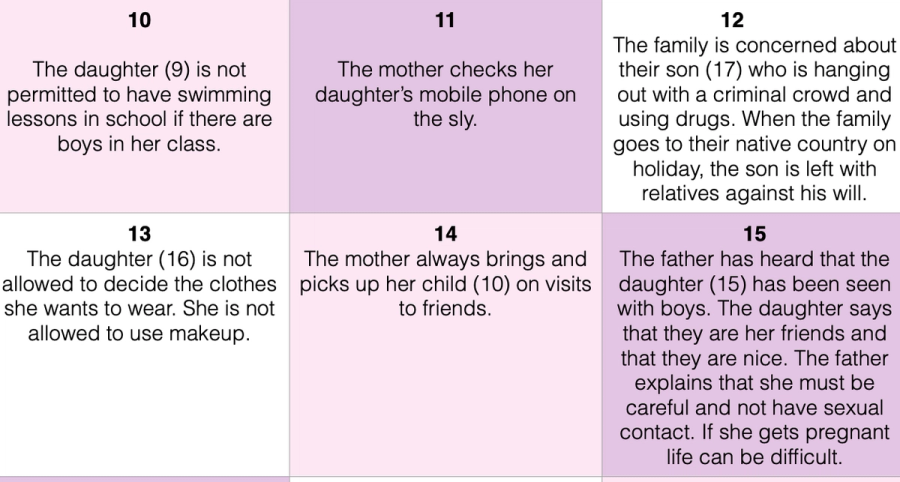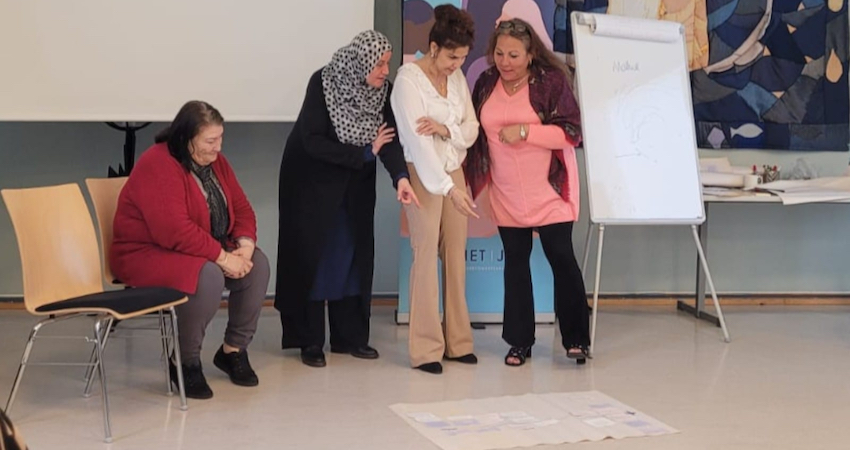Care or control?
Social control is the very glue that holds society together. At times, however, this control may be so strict that it has negative consequences for the individual’s life and freedom. In this group work the participants will analyse different situations and discuss whether positive or negative social control is present.
Quick facts




Activity goals
- To reflect on social control and gain insight into what negative social control is.
- Raise awareness that negative social control restricts human freedom and may be in contravention of human rights and national law.

Preparation
- Introduction on what social control and negative social control are.
- 21 situation cards for each group.
- Conclusion situation cards.
Instructions
- The facilitator presents the introduction:
- There is always an element of influence and control when people come together. This type of “social control” gets us to go to doctor’s appointments on time, not jaywalk, say hello politely to our neighbours and gets children to listen to their parents. Social control develops a shared understanding of how to behave and act in relation to others.
- Occasionally the social control may be so strict that it has a negative effect. There is a thin line between positive and negative social control. When the control leads to systematic forms of supervision, threats and coercion to force individuals to live in compliance with family or group norms, it is called “negative social control”.
- Because there is a thin line between positive and negative social control, and because the latter can have dire consequences, it is important to improve our knowledge and to reflect. Then it will be easier to discover and prevent negative social control.
- Divide the participants into groups of 4-6 (30-40 minutes). Each group is given 21 situation cards (download cards). The groups must discuss and place the cards along a line drawn on the flip-over sheet. Positive social control is one end of the line, negative social control is the other end. There must be ample space between the endpoints to place the cards.
- To help in assessing the situations we recommend using the following definition: Negative social control involves various forms of supervision, pressure, threats and coercion exercised to make sure that individuals live in compliance with the family or group norms. The control characteristically can be systematic and may violate individual rights pursuant to the UN Convention on the Rights of the Child. (The Norwegian Directorate of Health).
- This can be summed up in a plenary session in different ways depending on the number of participants and the time available. If there are few groups and ample time, all the situations can be reviewed. One group may first explain what they thought about a situation before others comment. Do they agree or not? Do they have other arguments? Then another group can present a new situation before the others are given the floor.
- If there are many groups and not as much time, each group can, for example, be asked to select and present two or three of the situations in the plenary session where there was the most disagreement or the most interesting and/or difficult discussions. Experience suggests that this is a productive way of doing this. Often relevant and important discussions will be highlighted and discussed.
Reflection
- Is it always easy to see where the boundaries are between positive and negative social control?
- Do we always understand if we are subjected to negative social control?
- Are we always aware that we ourselves are exercising negative social control (for example with our children)?
- What can we do to prevent negative social control?
Debriefing
At its best, social control creates security and predictability in our lives. But at times this control may be so strict that it has harmful consequences and may violate national laws and human rights. There is a thin line between positive and negative social control. Negative social control occurs when a person is subjected to systematic monitoring, threats, pressure or coercion. If we, personally, or others experience negative social control, we should talk to someone we trust or contact the assistance services.
Follow-up activities
The participants are divided into groups of 4-6, each of which is to answer each their question (20-30 minutes):
- Who exercises negative social control? Why do they do this?
- Who is most exposed to negative social control? Why are they subjected to such control?
- What are the consequences of being subjected to negative social control? Try to find facts or news items that can illuminate this.
While the groups are working the facilitator should make sure that the questions have been understood correctly. The groups present their results in a plenary session. The facilitator fills in if important points are not mentioned. If the activity takes a long time, it can be a good idea to take a break or use an energizer.
(English translation: John Anthony)



